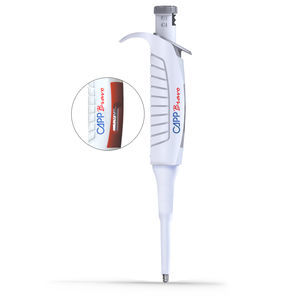
Mechanical micropipette Solopistonsingle-channelvariable-volume
Add to favorites
Compare this product
Characteristics
- Operational mode
- mechanical
- Type
- piston
- Number of channels
- single-channel
- Volume option
- variable-volume, fixed-volume
- Other characteristics
- autoclavable
- Volume
Max.: 10 ml
(0.3381 US fl oz)Min.: 0.1 ml
(0.0034 US fl oz)
Description
The new CAPPSolo single channel pipettes are built to meet the liquid-transfer needs of the modern laboratory. These dependable work-horses are the ideal micropipette for research, clinical and academic laboratories that require great quality without breaking the bank. Here are some brief highlights of what you can expect from these excellent automatic pipettes.
High precision automatic pipettes
CAPPSolo automatic pipettes have excellent calibration retention and a precise volume adjustment mechanism. These features ensure accurate volume dispensing making it easy to dial in the desired liquid volume on your automatic pipette. Coupled with the lockable counter mechanism, the high precision volume adjustment feature of CAPPSolo single channel pipettes commoditizes accurate and repeatable liquid dispensing. With CAPPSolo single channel pipettes you always get the precise volume whether you’re pipetting 0.1 µL or 10.000 µL.
Comfortable, lightweight micropipettes
With the sturdy and lightweight chassis of CAPPSolo single channel pipettes it is now easy to pipette through large sample volumes comfortably. The well balanced chassis reduces unnecessary weight without compromising the overall quality of the micropipette. This means that CAPPSolo single channel pipettes actively reduce the incidence of repetitive strain injury amongst workers that use these micropipettes for protracted periods of time.
Catalogs
Pipetting Instruments
32 Pages
CAPP® CATALOGUE 2023/24
84 Pages
Related Searches
- Sample tube
- Laboratory centrifuge
- Tabletop centrifuge
- Laboratory sample tube
- Laboratory stirrer
- Microtiter plate
- General purpose laboratory stirrer
- Blood centrifuge
- Benchtop laboratory stirrer
- Agitator
- 96-well microplate
- Digital laboratory stirrer
- Pipette tip
- Universal centrifuge
- Laboratory microplate
- Pipette
- Benchtop stirrer
- Polypropylene sample tube
- Digital stirrer
- Automated centrifuge
*Prices are pre-tax. They exclude delivery charges and customs duties and do not include additional charges for installation or activation options. Prices are indicative only and may vary by country, with changes to the cost of raw materials and exchange rates.









